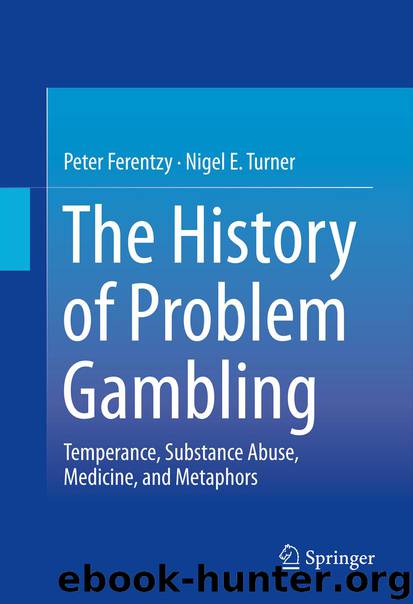The History of Problem Gambling by Peter Ferentzy & Nigel E. Turner

Author:Peter Ferentzy & Nigel E. Turner
Language: eng
Format: epub
Publisher: Springer New York, New York, NY
5.3 The Development of an Opiate Addiction Concept: Alcohol, Denial, and the Need for Ascendancy
Already in the eighteenth century, one could find discussions in the West of what today would be called physical dependence. The Mysteries of Opium Reveal’d, written by John Jones and published in 1700, contains some sober comments on the withdrawal phenomenon as well the consequences of excessive doses. One feature distinguishing this text from later nineteenth-century accounts is an absence of judgmental attitudes (though Jones does identify “long and lavish use” as a form of “habitual intemperance”) (Jones, 1700, pp. 32, 238–244, 245). The same can be said of Samuel Crumpe’s An Inquiry into the Nature and Properties of Opium, published in 1793 (Crumpe, 1793). Berridge and Edwards (1987) have noted the lack of “moral condemnation or alarm” (p. xxv). The latter would come often in the form (or guise) of psychological evaluation. While Courtwright (1982) correctly identifies 1895–1935 as key to the transformation of the addict into a derelict, this transformation had precedents in the mid-nineteenth century, as medical wisdom was already transforming the addict into a liar and the lower-class addict into a prototype for the subhuman addict to come (Berridge & Edwards, 1987, pp. 105–109; Berridge, 1978). To be sure, as opiate use became less acceptable, users would be more likely to lie about it – hence, the empirical validity of at least some of the science.
What must concern us here—whether our area is alcoholism, drug addiction or problem gambling—is the way in which addiction came to be identified as a condition which, in itself, causes one to lie. Here, an entire “science” of the soul was built around historically specific developments. Major mid-nineteenth-century figures—Jonathan Pereira in Britain, George Wood in the United States, and Edward Levenstein in Germany—each independently reached similar conclusions regarding the chronic opiate user’s propensity to lie and suffer moral decline (Pereira, 1853; Wood, 1868; Levenstein, 1878a/1981). According to Pereira, “It is extremely difficult to discontinue the vice of opium-smoking, yet there are many instances of it being done. The continuance of this destructive practice deteriorates the physical constitution and moral character of the individual, especially among the lower classes” (Pereira, 1853, p. 2013). Yet one could witness differences, as the American author George Wood was considerably less critical of opiates than his British counterpart. It seems that strong condemnation of opiates came a bit later in the USA than in Britain. Musto (1973) has identified England’s opium wars with China as a possible reason for this difference. The opium war was fought to open up free trade in opium into China. The British were forcing the Chinese to buy opium from them. This makes Musto’s connection somewhat puzzling. The link perhaps is that the war led to a greater trade in opium and greater usage of opium and drew social attention on opium as a potential issue. Before then, opium was largely irrelevant. Another explanation could be America’s harsher treatment of alcohol, which Wood considered more dangerous than opium (Wood, 1868, pp.
Download
This site does not store any files on its server. We only index and link to content provided by other sites. Please contact the content providers to delete copyright contents if any and email us, we'll remove relevant links or contents immediately.
Rewire Your Anxious Brain by Catherine M. Pittman(18589)
Talking to Strangers by Malcolm Gladwell(13291)
The Art of Thinking Clearly by Rolf Dobelli(10324)
Mindhunter: Inside the FBI's Elite Serial Crime Unit by John E. Douglas & Mark Olshaker(9263)
Becoming Supernatural by Dr. Joe Dispenza(8167)
Change Your Questions, Change Your Life by Marilee Adams(7684)
Nudge - Improving Decisions about Health, Wealth, and Happiness by Thaler Sunstein(7657)
The Road Less Traveled by M. Scott Peck(7555)
The Lost Art of Listening by Michael P. Nichols(7453)
Mastermind: How to Think Like Sherlock Holmes by Maria Konnikova(7278)
Enlightenment Now: The Case for Reason, Science, Humanism, and Progress by Steven Pinker(7273)
Win Bigly by Scott Adams(7139)
The Way of Zen by Alan W. Watts(6553)
Daring Greatly by Brene Brown(6473)
Big Magic: Creative Living Beyond Fear by Elizabeth Gilbert(5677)
Grit by Angela Duckworth(5555)
Ego Is the Enemy by Ryan Holiday(5347)
Men In Love by Nancy Friday(5192)
The Laws of Human Nature by Robert Greene(5080)
